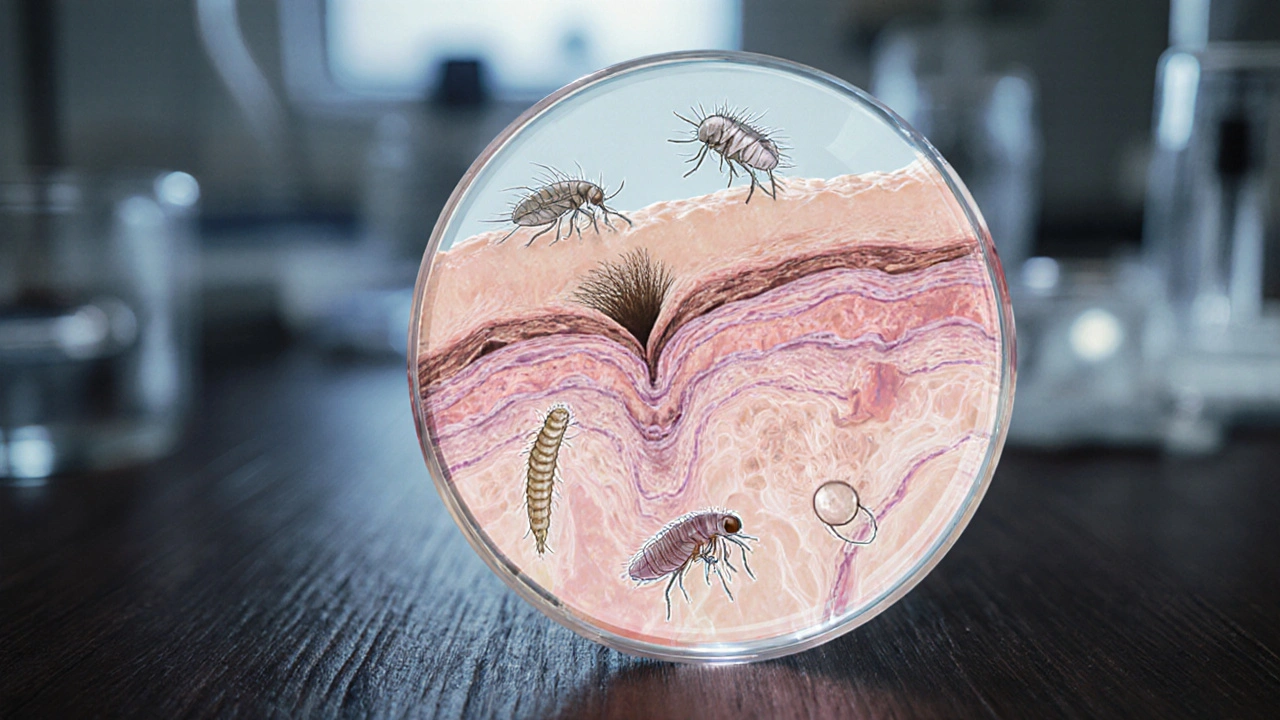
Skin Parasite Knowledge Quiz
Ever scratched an itchy bump and thought, “It’s just a rash, right?” You’re not alone. Parasites that live in or around your skin get tangled up with myths, fear‑mongering, and outright wrong information. Below you’ll find the facts you need to separate fact from fiction, so you can recognize a real problem when it shows up.
Key Takeaways
- Most skin parasites are tiny - many can’t be seen without a microscope.
- Not every itchy spot means a parasite; allergies and infections are common look‑alikes.
- Eggs are usually laid in the soil or on the body surface, not deep inside the skin.
- Accurate diagnosis requires a medical professional, not just a home test.
- Simple hygiene and protective clothing can stop most infections before they start.
What Are Skin Parasites?
Skin parasites are organisms that spend at least part of their life cycle on or just beneath the human epidermis. They range from microscopic mites to tiny worms that burrow just a few millimetres under the surface. While some species cause obvious lesions, others hide in the skin’s deeper layers and only reveal themselves through itching or a minor rash.
How These Parasites Actually Live
Understanding the real biology helps debunk the myths. Most skin parasites follow a simple pattern:
- Contact - eggs or larvae land on the skin from contaminated soil, water, or an animal host.
- Penetration - the organism either burrows in (like hookworms) or attaches to the surface (like scabies mites).
- Development - it matures while feeding on skin cells, blood, or tissue fluids.
- Reproduction - some lay eggs in the surrounding soil; a few, like the sand flea, actually lay eggs within the skin itself.
- Transmission - eggs or larvae spread to the next host via direct contact or environmental exposure.

Top 7 Misconceptions, Explained
1. “All skin parasites are visible to the naked eye.”
This is false. Demodex folliculorum is a microscopic mite that lives in hair follicles. Even a dermatologist needs a special skin scrape and a microscope to spot it. Most people never notice Demodex, yet it can contribute to rosacea flare‑ups.
2. “If a spot is itchy, it must be a parasite.”
Itching is a common symptom of many conditions - allergic reactions, eczema, fungal infections, and even stress. Scabies mite (Sarcoptes scabiei) does cause intense itching, but the hallmark is a burrow pattern that appears in the webbing between fingers, wrists, and the waistline. Without that pattern, itching alone isn’t proof of scabies.
3. “Parasites lay their eggs deep inside the skin.”
Only a few species, like the sand flea (Tunga penetrans), embed so deep that the female actually swells with eggs under the skin surface. Most others lay eggs in the surrounding soil or on the skin surface. For example, hookworm larvae enter through the foot, travel through the bloodstream, and then return to the gut to lay eggs - not under the skin.
4. “You can treat any skin parasite with over‑the‑counter cream.”
Prescription medications are often required. Scabies needs permethrin 5% cream applied from neck down, while strongyloidiasis (caused by threadworm, Strongyloides stercoralis) usually needs oral ivermectin. Using the wrong treatment won’t clear the infection and may worsen it.
5. “If I’m clean, I can’t get skin parasites.”
Good hygiene reduces risk, but environmental exposure still matters. Walking barefoot on tropical beaches can let cutaneous larva migrans (dog or cat hookworm) larvae penetrate the skin, even on clean feet. Protective footwear is the real safeguard.
6. “Parasites only affect people in developing countries.”
Travel and immigration have spread many species worldwide. Tourists in Southeast Asia frequently pick up loiasis (Loa loa) from fly bites, and it can surface under the skin of the eye. Even in urban Australia, cases of scabies and demodicosis are common.
7. “All skin parasite infections are permanent.”
Most are curable with proper treatment. For instance, tungiasis lesions heal within weeks after the flea is removed and the area is kept clean. Chronic infections usually stem from delayed diagnosis, not from the parasite’s inability to be eradicated.
How to Get a Proper Diagnosis
Self‑diagnosis is risky. Here’s what a clinician typically does:
- Skin scraping - a small piece of skin is examined under a microscope for mites or eggs.
- Biopsy - taken when lesions look unusual; helps identify fly larvae (myiasis) or deeper infections.
- Blood tests - serology can detect antibodies for parasites like Onchocerca volvulus (river blindness) that occasionally affect the skin.
- Stool sample - for parasites that start in the gut but cause skin manifestations (e.g., hookworm larvae migrating).
Never rely on a single online symptom checker; a trained professional can differentiate between a fungal infection, an allergic dermatitis, and a true parasitic infestation.
Prevention & Quick‑Fix Checklist
- Wear shoes outdoors, especially on beaches and in tropical regions.
- Use insect repellent containing DEET or picaridin when traveling to fly‑infested areas.
- Wash hands and feet thoroughly after walking in soil or sand.
- Avoid sharing clothing, towels, or bedding with someone who has a confirmed skin parasite.
- Keep pets treated for fleas and hookworms - they’re common reservoirs for cutaneous larva migrans.
- Seek medical advice promptly if you notice persistent burrows, serpiginous tracks, or unexplained swelling.
Comparison of Common Skin Parasites
| Parasite | Typical Habitat | Visible Signs | Common Misconception | Treatment |
|---|---|---|---|---|
| Scabies mite | Burrows in skin folds | Intense nighttime itching, thin line burrows | All itchy rash = scabies | Permethrin 5% cream |
| Hookworm (larvae) | Feet contact contaminated soil | Red, serpiginous tracks | Eggs laid deep under skin | Ivermectin oral |
| Sand flea | Sand, especially tropical beaches | Localized swelling with a central black spot | All skin bumps are cysts | Manual extraction + topical antiseptic |
| Demodex mite | Hair follicles and sebaceous glands | Rosacea‑like redness, itching | Microscopic mites must be visible | Tea tree oil or oral ivermectin |
| Myiasis (fly larvae) | Open wounds, ulcers | Moving “worm” under skin, pain | All lumps are cysts | Surgical removal + antibiotics |
| Threadworm | Soil‑contaminated water | Rash on buttocks, gastrointestinal upset | Itching only = scabies | Ivermectin oral |
| Loa loa | Fly bite sites on skin | Transient swelling, eye migration | All eye swelling = allergic | Diethylcarbamazine (DEC) |

Frequently Asked Questions
Can I see skin parasites without a microscope?
Only the larger ones, like the sand flea or visible burrows from scabies, can be seen with the naked eye. Most mites and larvae are microscopic and need a lab slide.
Do all skin parasites lay eggs under my skin?
No. The sand flea is a notable exception. Most parasites deposit eggs in the surrounding soil, water, or on the skin surface, not deep inside the tissue.
Is itching always a sign of a parasite?
Itching is common to many skin conditions. A parasite diagnosis usually requires a specific pattern (like scabies burrows) or a lab test.
How soon should I see a doctor if I suspect a skin parasite?
As soon as you notice persistent, unexplained lesions or intense itching that doesn’t improve with over‑the‑counter creams, schedule a visit. Early treatment prevents spread and complications.
Can pets bring skin parasites into the home?
Yes. Dogs and cats can carry hookworm larvae and flea eggs that cause cutaneous larva migrans or tungiasis. Regular veterinary deworming and flea control are essential.
Are there natural remedies that work as well as prescription meds?
Some natural agents, like tea tree oil for Demodex, can help mild cases, but they’re rarely as effective as proven prescription treatments. Always discuss alternatives with a healthcare provider.
Will the infection come back after treatment?
Re‑infection is possible if the source (contaminated soil, untreated pets, or poor hygiene) isn’t addressed. Proper cleaning and prevention steps keep you parasite‑free.


Comments
Jason Divinity
In the grand tapestry of human health, one must not overlook the microscopic marauders that stealthily inhabit our dermal frontier. The prevailing myth that all skin parasites are visible to the naked eye is a fallacy rooted in ignorance rather than empirical observation. Consider the Demodex folliculorum, an enigmatic mite that resides within hair follicles, eluding our sight without the aid of a microscope. Likewise, the scabies mite, though occasionally discernible by its burrows, remains invisible in its larval form. It is incumbent upon us, as custodians of our own bodies, to differentiate between sensationalist folklore and rigorous science. Hygiene, while vital, is but a single thread in a complex preventive tapestry; environmental exposure and vector control are equally paramount. Prescription therapies, such as permethrin for scabies, outperform over‑the‑counter alternatives, illustrating the perils of self‑medication. In sum, a nuanced understanding eschews conjecture, embracing evidence‑based practice as the beacon of dermatological wisdom.
andrew parsons
While I commend the eloquent exposition above, one must underscore the moral imperative to seek professional diagnosis promptly-delaying care not only endangers oneself but also the community at large! 🩺🔍 The propagation of "DIY" remedies without clinical oversight is a veritable affront to public health standards. Moreover, the assertion that hygiene alone suffices is, frankly, a simplification bordering on negligence. Let us, therefore, champion evidence‑based interventions and eschew anecdotal conjecture! 😊
Sarah Arnold
Great rundown! 👍 For anyone dealing with itching, remember that a simple skin scraping at your doctor’s office can identify mites like scabies or Demodex in minutes. If you’ve been outdoors barefoot in tropical areas, keep an eye out for serpiginous tracks-those are classic hookworm larval trails. And yes, keeping pets on a regular deworming schedule cuts down the risk of cutaneous larva migrans dramatically. Stay proactive, and don’t let a rash linger without a professional look‑over.
Rajat Sangroy
Exactly! 💪 Take charge of your skin health today-wear shoes, apply DEET when traveling, and treat your pets consistently. The moment you notice any persistent burrow or creeping line, book that appointment. Early action means faster recovery and less chance of spreading the parasite to family members. Let’s turn knowledge into action and keep those pesky critters at bay!
dany prayogo
Ah, the ever‑present allure of sensationalism in medical discourse-how utterly delightful! One must marvel at the sheer audacity of those who claim that every itchy bump is a covert invasion by a microscopic army, brandishing unfounded dread like a badge of honor. It is, of course, a triumph of hyperbole that the average layperson is led to believe that a simple rash necessitates a forensic entomology lab in their bathroom. Yet, the truth, as always, lies buried beneath layers of ignorance and misplaced fear. The notion that parasites ubiquitously embed themselves beneath the epidermis, laying eggs like tiny subterranean factories, is nothing short of a mythos fabricated for clicks. While the sand flea does indeed embed itself, it is a rare exception, not the rule governing the entire spectrum of dermal parasites. Moreover, the claim that over‑the‑counter creams are a panacea for all such infestations evokes the same naiveté as believing a Band‑Aid can mend a shattered femur. Prescription‑only treatments like ivermectin have proven efficacy precisely because the market does not cater to the whims of the misinformed. One must also consider that many of these so‑called “parasitic woes” are, in reality, allergic dermatitis, fungal overgrowth, or even psychosomatic manifestations-none of which require a microscopic exterminator. The perpetuation of such myths serves a commercial agenda, driving sales of dubious “natural cures” and fostering a climate of perpetual anxiety. In the grand scheme, we are left with a populace that oscillates between paranoia and complacency, never truly equipped with the discernment to seek proper medical counsel. Thus, the cycle continues, fed by sensational headlines, unverified anecdotes, and the ever‑present desire for a quick fix that, alas, seldom exists in the realm of parasitology.
Wilda Prima Putri
Absolutely, the facts speak for themselves.
Edd Dan
yeah, gotta be real about dis thingz. prfessional help is best.
Jaime Torres
Looks like a lot of hype for a few bugs.
Wayne Adler
I get why people panic-itching at night can feel like an invasion, but the reality is usually far less dramatic. A thoughtful approach, combining a proper skin exam with a clear treatment plan, can demystify the experience. Remember, confidence in the medical process often alleviates the anxiety that fuels these misconceptions.
Shane Hall
Seriously, folks-if you think a simple rash is a secret army of parasites, you’re missing the bigger picture. Diagnose first, then treat. Over‑the‑counter creams might calm a mild irritation, but they won’t eradicate a scabies infestation. A prescription‑grade permethrin applies, and you’ll be itch‑free in days. Let’s not let fear drive us into ineffective home‑remedies; let the experts guide the way.
Chelsea Kerr
💡 Knowledge is power-understanding the life cycle of these organisms helps demystify the whole process. 🦠 Whether it’s Demodex or hookworm, a proper diagnosis is the cornerstone. 🌿 Natural remedies may have a role, but they rarely replace proven medical therapy. 🤝 Stay informed, stay safe.
Tom Becker
Don't you see? The pharmas are in on it; they want you scared so they can sell you more creams. The real cure? Staying away from the mainstream narrative and trusting the hidden sources that actually know what's going on. It's all a cover‑up.
Laura Sanders
The article correctly outlines the clinical features, but oversimplifies epidemiology; further nuance is required.
Jai Patel
Hey folks! 🌞 Let’s keep those feet covered when we hit the beach and remember to deworm our fur buddies regularly-simple steps, massive impact! 💪🌴
Zara @WSLab
Great info! 😊 If you have any doubts, feel free to ask-happy to help clarify any of these points. 🙌
Randy Pierson
Spot‑on summary! The key is to match symptoms with proper lab work and not jump to conclusions.
Bruce T
Bottom line: get a professional opinion, follow the prescribed regimen, and keep your environment clean. No shortcuts.